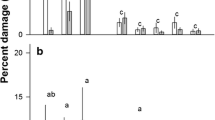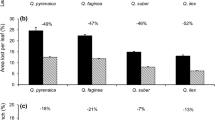Abstract
Young leaves of most species experience remarkably higher herbivore attack rates than mature leaves. Considerable theoretical effort has focused on predicting optimal defense and tradeoffs in defense allocation during leaf expansion. Among others, allocation to secondary chemistry may be dependent on growth constraints. We studied flavanoid production during leaf development in two species of Inga (Fabaceae: Mimosoideae) with different expansion strategies: Inga goldmanii, a species with slowly expanding young leaves, and Inga umbellifera, a species with fast-expanding young leaves. In these two species, the most abundant and toxic class of defensive compounds is flavanoids (which include tannins). We measured their concentration by leaf dry weight, their total content per leaf, their HPLC chemical profile and their toxicity to a generalist herbivore at different expansion levels. Although in both species the flavanoid concentration decreased with increasing leaf expansion, that decrease was twice as pronounced for I. umbellifera as it was for I. goldmanii. I. umbellifera leaves produced flavanoids only during the first half of their development while I. goldmanii leaves continued production throughout. The changes in flavanoid HPLC profiles and toxicity were also more dramatic for I. umbellifera, which had different flavanoids in young than in mature leaves. Relative to I. umbellifera, I. goldmanii showed smaller changes in both flavanoid composition and toxicity in the transition from young to mature leaves. These results indicate that, even though young leaves suffer higher rates of attack and are predicted to have better chemical defenses than mature leaves, growth constraints may modulate defense allocation and thus, evolution of defense strategies.




Similar content being viewed by others
References
Ayres MP, Clausen TP, MacLean SF Jr, Redman AM, Reichardt PB (1997) Diversity of structure and antiherbivore activity in condensed tannins. Ecology 78:1696–1712
Baldwin IT, Karb MJ (1995) Plasticity in allocation of nicotine to reproductive parts in Nicotiana attenuata. J Chem Ecol 21:897–909
Brooks JS, Feeny PP (2004) Seasonal variation in Daucus carota leaf-surface and leaf-tissue chemical profiles. Biochem Syst Ecol 32:769–782
Coley PD (1983) Herbivory and defensive characteristics of tree species in a lowland tropical forest. Ecol Monogr 53:209–233
Coley PD (1988) Effects of plant growth rate and leaf lifetime on the amount and type of anti-herbivore defense. Oecologia 74:531–536
Coley PD, Aide MT (1991) Comparison of herbivory and plant defenses in temperate and tropical broad-leaved forests. In: Price PW, Lewinson TM, Fernandes GW, Benson WW (eds) Plant–animal interactions: evolutionary ecology and temperate regions. Wiley, New York, pp 25–49
Coley PD, Kursar TA (1996) Anti-herbivore defenses of young tropical leaves: physiological constrains and ecological tradeoffs. In: Mulkey SS, Chazdon RL (eds) Tropical forest plant ecophysiology. Chapman & Hall, New York, pp 305–336
Coley PD, Lokvam J, Rudolph K, Bromberg K, Wright L, Brenes-Arguedas T, Dvorett D, Ring S, Ponge A, Baptiste C, Pennington TR, Kursar TA (2005) Divergent defensive strategies of young leaves in two Neotropical species of Inga. Ecology 86:2633–2643
Cornelissen TG, Fernandes GW (2001) Defence, growth and nutrient allocation in the tropical shrub Bauhinia brevipes (Leguminosae). Aust Ecol 26:246–253
Crankshaw DR, Langenheim JH (1981) Variation in terpenes and phenolics through leaf development in Hymenaea and its possible significance to herbivory. Biochem Syst Ecol 9:115–124
Croat TB (1978) Flora of Barro Colorado Island. Stanford University Press, Stanford
Feeny PP (1970) Seasonal changes in oak leaf tannins and nutrients as a cause of spring feeding by winter moth caterpillars. Ecology 51:565–581
Forkner RE, Marquis RJ, Lill JT (2004) Feeny revisited: condensed tannins as anti-herbivore defences in leaf-chewing herbivore communities of Quercus. Ecol Entomol 29:174–187
Haukioja E (2003) Putting the insect into the birch–insect interaction. Oecologia 136:161–168
Herms DA, Mattson WJ (1992) The dilemma of plants: to grow or defend. Q Rev Biol 67:283–335
Jones CG, Hartley SE (1999) A protein competition model of phenolic allocation. Oikos 86:27–44
Kleiner KW, Ellis DD, McCown BH, Raffa KF (2003) Leaf ontogeny influences leaf phenolics and the efficacy of genetically expressed Bacillus thuringiensis cry1A(a) δ-endotoxin in hybrid poplar against gypsy moth. J Chem Ecol 29:2585–2602
Koptur S (1984) Experimental evidence of defense of Inga (Mimosoidead) saplings by ants. Ecology 65:1787–1793
Koricheva J (1999) Interpreting phenotypic variation in plant allelochemistry: problems with the use of concentrations. Oecologia 119:467–473
Kursar TA, Coley PD (1991) Nitrogen content and expansion rate of young leaves of rain forest species implications for herbivory. Biotropica 23:141–150
Kursar TA, Coley PD (1992a) Delayed development of the photosynthetic apparatus in tropical rain forest species. Funct Ecol 6:411–422
Kursar TA, Coley PD (1992b) Delayed greening in tropical leaves an antiherbivore defense? Biotropica 24:256–262
Kursar TA, Coley PD (2003) Convergence in defense syndromes of young leaves in tropical rainforests. Biochem Syst Ecol 31:929–949
Laitinen ML, Julkunen-Tiitto R, Rousi M (2002) Foliar phenolic composition of European white birch during bud unfolding and leaf development. Physiol Plant 114:450–460
Lambdon PW, Hassall M, Boar RR, Mithen R (2003) Asynchrony in the nitrogen and glucosinolate leaf-age profiles of Brassica: is this a defensive strategy against generalist herbivores? Agric Ecosyst Environ 97:205–214
Langenheim JH, Macedo CA, Ross MK, Stubblebine WH (1986) Leaf development in the tropical leguminous tree Copaifera in relation to microlepidopteran herbivory. Biochem Syst Ecol 14:51–59
Leigh EGJ, Rand AS, Windsor DM (1996) The ecology of a tropical forest: seasonal rhythms and long-term changes, 2nd edn. Smithsonian Institution Press, Washington, D.C.
Lokvam J, Kursar TA (2005) Divergence in structure and function of phenolic defenses in young leaves of two co-occurring Inga species. J Chem Ecol
Lokvam J, Coley PD, Kursar TA (2004) Cinnamoyl glucosides of catechin and dimeric procyanidins from young leaves of Inga umbellifera (Fabaceae). Phytochemistry 65:351–358
Lokvam J, Brenes-Arguedas T, Lee SJ, Coley PD, Kursar TA (2006) Allelochemic function for a primary metabolite: the case of L-tyrosine hyper-production in Inga umbellifera (Fabaceae). Am J Bot (in press)
Loomis WE (1932) Growth-differentiation balance versus carbohydrate ratio. Proc Am Soc Hortic Sci 29:240–245
Nichols-Orians CM, Schultz JC (1990) Interactions among leaf toughness, chemistry, and harvesting by attine ants. Ecol Entomol 15:311–320
Numata S, Kachi N, Okuda T, Manokaran N (2004) Delayed greening, leaf expansion, and damage to sympatric Shorea species in a lowland rain forest. J Plant Res 117:19–25
Orians GH, Janzen DH (1974) Why are embryos so tasty? Am Nat 108:581–592
Read J, Gras EK, Sanson GD, Clissold F, Brunt C (2003) Does chemical defence decline more in developing leaves that become strong and tough at maturity? Aust J Bot 51:489–496
Rhoades DF (1979) Evolution of plant chemical defense against herbivores. In: Rosenthal GA, Janzen DH (eds) Herbivores: their interaction with secondary plant metabolites, 1st edn. Academic Press, New York, pp 1–54
Riipi M, Ossipov V, Lempa K, Haukioja E, Koricheva J, Ossipova S, Pihlaja K (2002) Seasonal changes in birch leaf chemistry: are there trade-offs between leaf growth, and accumulation of phenolics? Oecologia 130:380–390
Ruusila V, Morin JP, van Ooik T, Saloniemi I, Ossipov V, Haukioja E (2005) A short-lived herbivore on a long-lived host: tree resistance to herbivory depends on leaf age. Oikos 108:99–104
Salminen JP, Ossipov V, Haukioja E, Pihlaja K (2001) Seasonal variation in the content of hydrolysable tannins in leaves of Betula pubescens. Phytochemistry 57:15–22
Salminen JP, Roslin T, Karonen M, Sinkkonen J, Pihlaja K, Pulkkinen P (2004) Seasonal variation in the content of hydrolyzable tannins, flavonoid glycosides, and proanthocyanidins in oak leaves. J Chem Ecol 30:1693–1711
Tikkanen OP, Julkunen-Tiitto R (2003) Phenological variation as protection against defoliating insects: the case of Quercus robur and Operophtera brumata. Oecologia 136:244–251
Turner IM (1995) Foliar defences and habitat adversity of three woody plant communities in Singapore. Funct Ecol 9:279–284
Valkama E, Salminen JP, Koricheva J, Pihlaja K (2004) Changes in leaf trichomes and epicuticular flavonoids during leaf development in three birch taxa. Ann Bot 94:233–242
Waterman PG, Mole S (1994) Analysis of phenolic plant metabolites. Blackwell, Oxford
Acknowledgements
We acknowledge financial support from the NSF (DEB 0108150 and DEB 0234936 to P. D. Coley and T. A. Kursar). Also, the Autoridad Nacional del Ambiente of Panama and Oris Acevedo of the Smithsonian Tropical Research Institute for facilitating sample collections. We are grateful to Jenny Burns, Leslie Wright, David Victor and Tobin Biesele for help with the bioassays, to Kathleen Rudolph and Keryn Bromberg, for the sample collection and to Franz Goller, Fred Adler, Collin Nichols-Orians, and three anonymous reviewers for valuable comments on the manuscript. The sample collections and export for this analysis were done in compliance with the laws of the Republic of Panama.
Author information
Authors and Affiliations
Corresponding author
Additional information
Communicated by Colin Orians
Electronic supplementary material
Rights and permissions
About this article
Cite this article
Brenes-Arguedas, T., Horton, M.W., Coley, P.D. et al. Contrasting mechanisms of secondary metabolite accumulation during leaf development in two tropical tree species with different leaf expansion strategies. Oecologia 149, 91–100 (2006). https://doi.org/10.1007/s00442-006-0423-2
Received:
Accepted:
Published:
Issue Date:
DOI: https://doi.org/10.1007/s00442-006-0423-2




